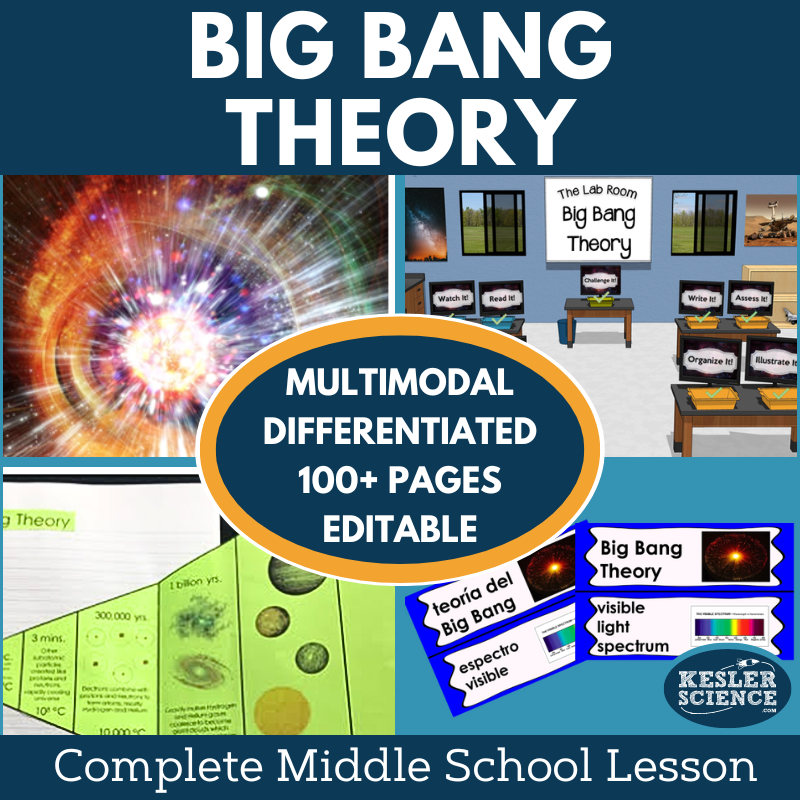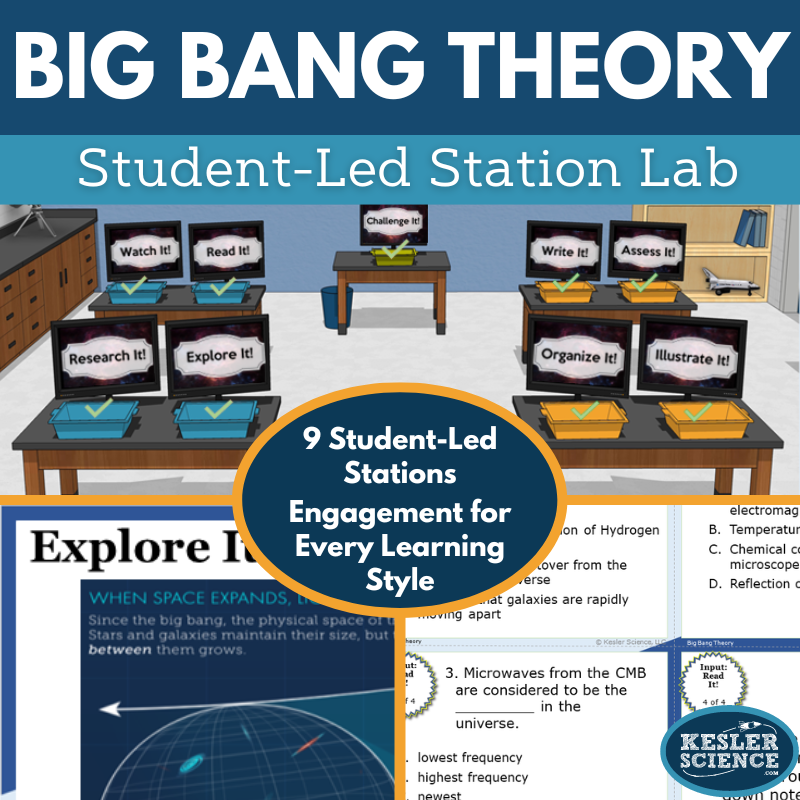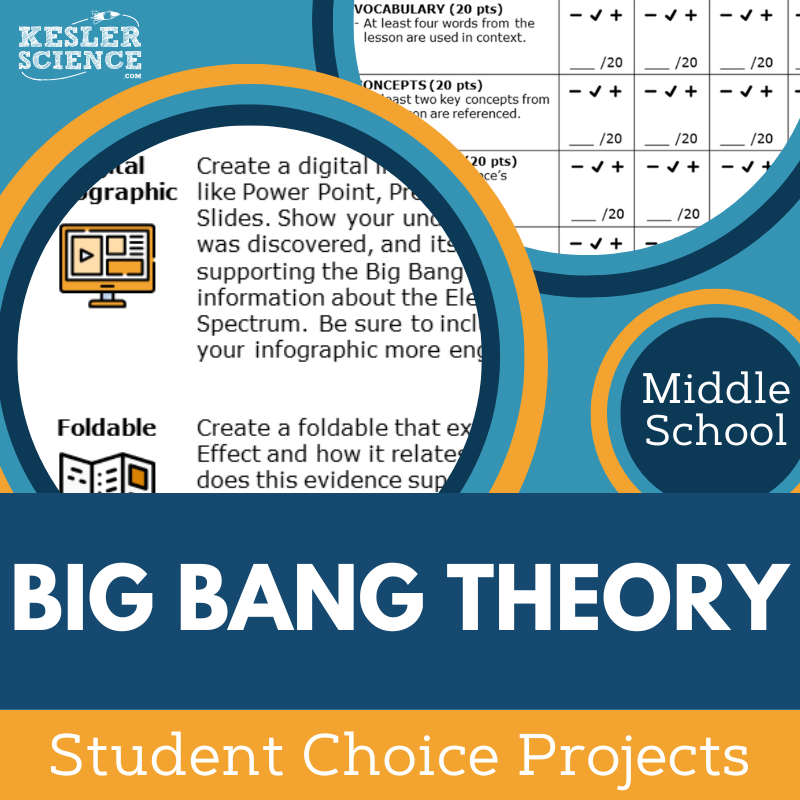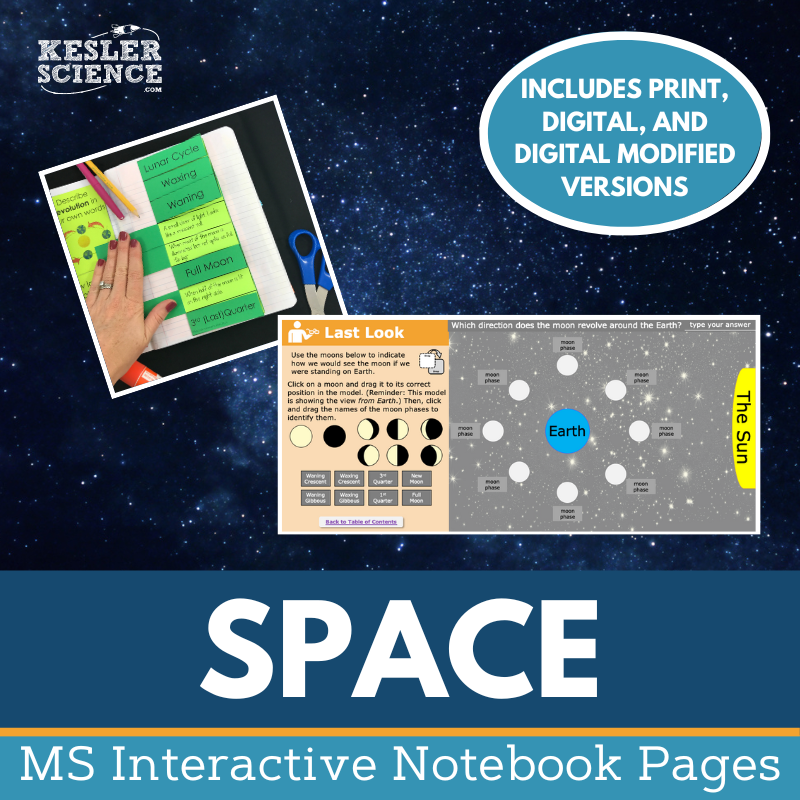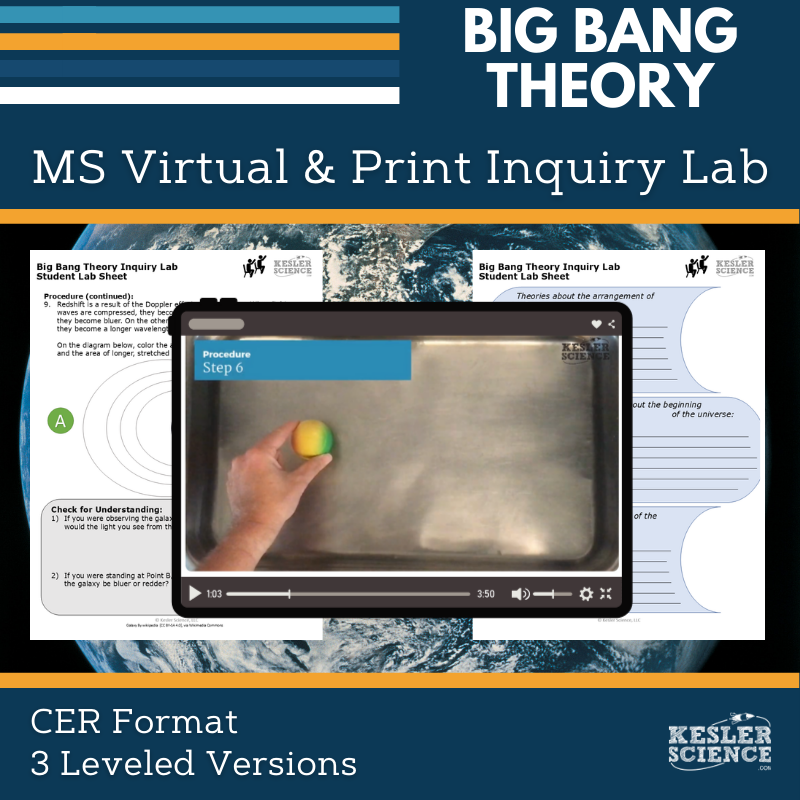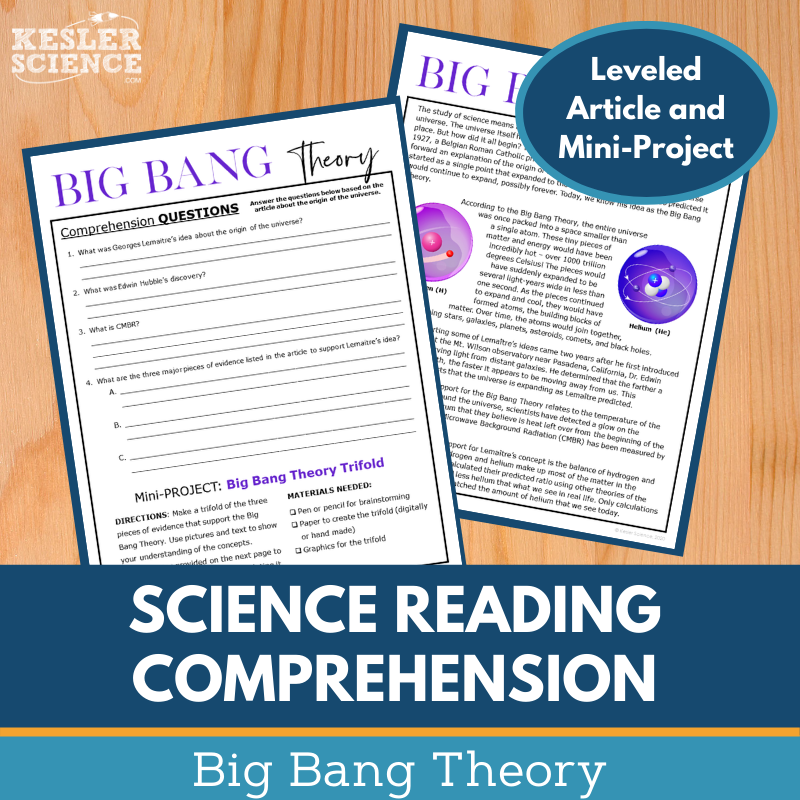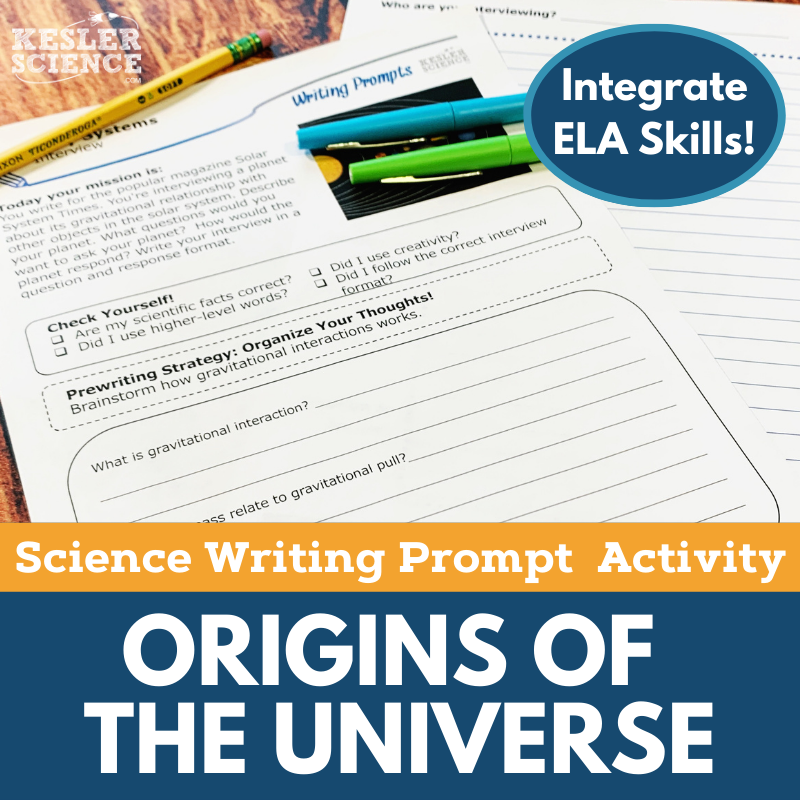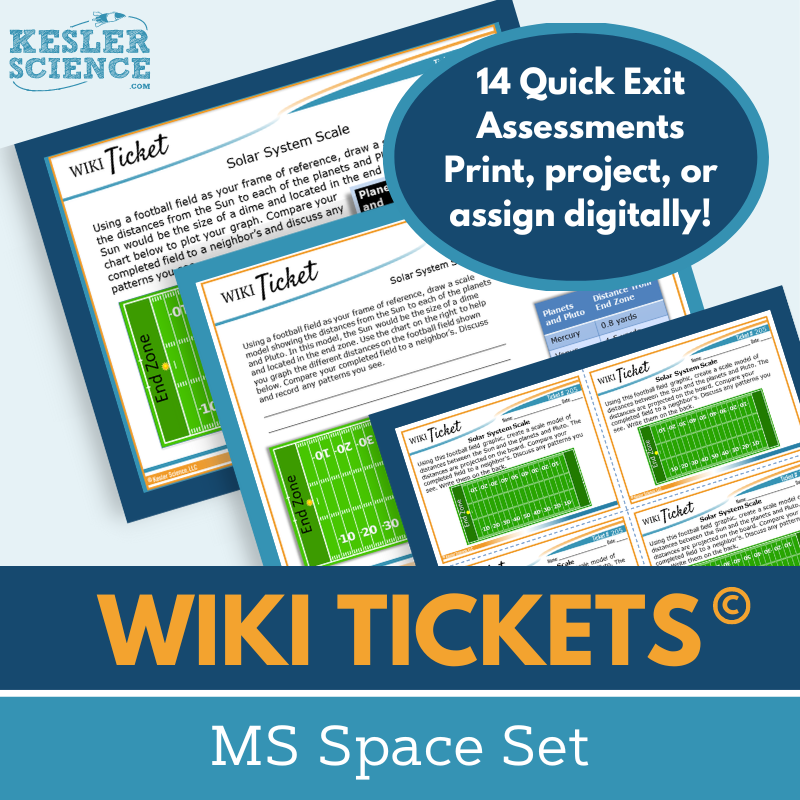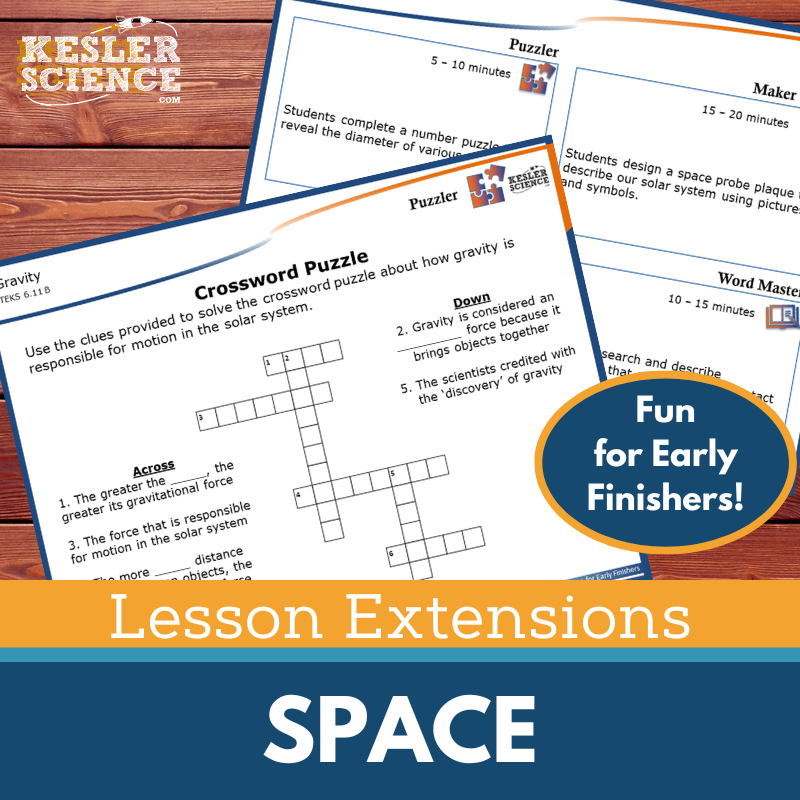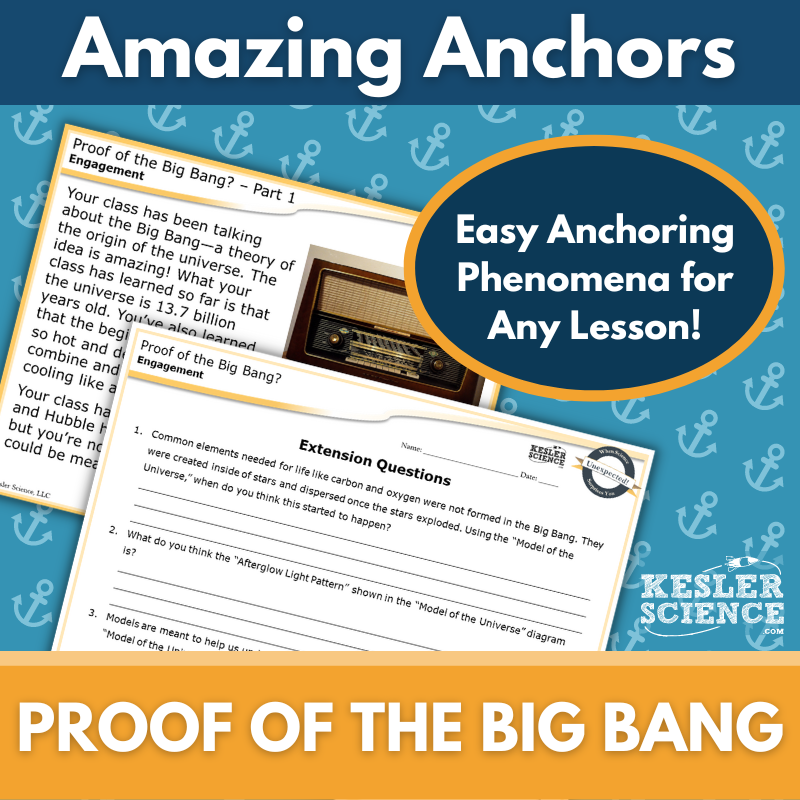Big Bang Theory Activities for Middle School Science
The Kesler Science Big Bang Theory Resources provide a comprehensive, engaging, and differentiated approach to teaching this essential space science topic to 6th-8th grade students. The resources below will give students a comprehensive understanding of the Big Bang theory. All of the following materials are also included in the Kesler Science Membership.
The Kesler Science Big Bang Theory 5E Complete Lesson equips 6th-8th grade teachers with everything needed for an engaging, multi-day lesson with minimal prep. Centered on the essential question, “What scientific evidence is used in constructing an explanation of the Big Bang theory?” this lesson offers differentiated, multimodal resources, editable formats, and Spanish translations to support all learners.
Following the 5E Model, students engage with objectives and vocabulary, explore through hands-on station labs, and explain concepts using editable PowerPoints and interactive notebooks. The nine station labs include activities like "Explore It!", "Read It!", and "Write It!", ensuring a mix of input and output opportunities. For elaboration, student-choice projects extend learning, while updated assessments provide tools for evaluation in alignment with NGSS and TEKS.
Designed for maximum flexibility, the materials are printable and digital, making them ideal for in-person or virtual learning. This lesson ensures student-led exploration and mastery of the Big Bang theory with fun, differentiated activities that foster critical thinking and engagement.
The Kesler Science Big Bang Theory 5E Complete Lesson equips 6th-8th grade teachers with everything needed for an engaging, multi-day lesson with minimal prep. Centered on the essential question, “What scientific evidence is used in constructing an explanation of the Big Bang theory?” this lesson offers differentiated, multimodal resources, editable formats, and Spanish translations to support all learners.
Following the 5E Model, students engage with objectives and vocabulary, explore through hands-on station labs, and explain concepts using editable PowerPoints and interactive notebooks. The nine station labs include activities like "Explore It!", "Read It!", and "Write It!", ensuring a mix of input and output opportunities. For elaboration, student-choice projects extend learning, while updated assessments provide tools for evaluation in alignment with NGSS and TEKS.
Designed for maximum flexibility, the materials are printable and digital, making them ideal for in-person or virtual learning. This lesson ensures student-led exploration and mastery of the Big Bang theory with fun, differentiated activities that foster critical thinking and engagement.
The Kesler Science Big Bang Theory Station Lab is a modular, student-led activity that engages middle school students in exploring how scientific data support theories about the universe's origin. With differentiated tasks and a teacher-as-facilitator approach, this lab provides a comprehensive, low-prep solution for fostering independent learning.
The lab features nine stations, including "Explore It!", "Research It!", "Read It!", and "Watch It!", which offer diverse ways for students to investigate the Big Bang theory. Output stations like "Organize It!", "Illustrate It!", and "Write It!" allow students to showcase their understanding creatively, while the "Challenge It!" station extends learning for advanced students.
Resources include all necessary signage, task cards, and digital adaptations for virtual learning. Whether in-person or online, this lab supports differentiated instruction with hands-on activities, reading passages in English and Spanish, and interactive digital components.
The Kesler Science Big Bang Theory Station Lab is a modular, student-led activity that engages middle school students in exploring how scientific data support theories about the universe's origin. With differentiated tasks and a teacher-as-facilitator approach, this lab provides a comprehensive, low-prep solution for fostering independent learning.
The lab features nine stations, including "Explore It!", "Research It!", "Read It!", and "Watch It!", which offer diverse ways for students to investigate the Big Bang theory. Output stations like "Organize It!", "Illustrate It!", and "Write It!" allow students to showcase their understanding creatively, while the "Challenge It!" station extends learning for advanced students.
Resources include all necessary signage, task cards, and digital adaptations for virtual learning. Whether in-person or online, this lab supports differentiated instruction with hands-on activities, reading passages in English and Spanish, and interactive digital components.
The Kesler Science Big Bang Theory Student Choice Projects empower middle school students to showcase their understanding through a personalized learning experience. Students select from six creative project options or design their own, allowing them to express knowledge in ways that align with their strengths. A detailed rubric supports assessments by teachers, peers, or students themselves, fostering self-directed learning.
This resource includes a nine-option project choice board, editable rubrics, and teacher directions for guidance. Differentiated materials cater to diverse learners, with a modified version targeting students needing extra support and flexible options for advanced students to tackle multiple projects.
Designed for simplicity, the projects require standard classroom supplies like paper, markers, and scissors, with optional digital or crafting elements. Whether in print or digital format, these projects are a dynamic way to engage students in exploring the Big Bang theory.
The Kesler Science Big Bang Theory Student Choice Projects empower middle school students to showcase their understanding through a personalized learning experience. Students select from six creative project options or design their own, allowing them to express knowledge in ways that align with their strengths. A detailed rubric supports assessments by teachers, peers, or students themselves, fostering self-directed learning.
This resource includes a nine-option project choice board, editable rubrics, and teacher directions for guidance. Differentiated materials cater to diverse learners, with a modified version targeting students needing extra support and flexible options for advanced students to tackle multiple projects.
Designed for simplicity, the projects require standard classroom supplies like paper, markers, and scissors, with optional digital or crafting elements. Whether in print or digital format, these projects are a dynamic way to engage students in exploring the Big Bang theory.
The Kesler Science Space Science Interactive Notebook is an engaging resource for teachers looking to create interactive learning experiences for their students. It includes both print and digital versions, making it perfect for traditional classrooms, 1:1 environments, or distance learning.
The bundle covers key space science topics such as asteroids, meteors, and comets, the Big Bang theory, eclipses, the electromagnetic spectrum, galaxies, and more. The digital version features a PowerPoint interactive notebook, which can be uploaded to Google Slides or learning management systems like MS Teams or Canvas. Reflection pages and space for students to take notes are included, along with a teacher answer key and modified versions for students with accommodations.
The print version provides a full set of blank templates for students, pre-filled templates for those needing modifications, and color photos to illustrate how each template should be used. This bundle is designed to support differentiated learning and keep students engaged in key space science concepts.
The Kesler Science Space Science Interactive Notebook is an engaging resource for teachers looking to create interactive learning experiences for their students. It includes both print and digital versions, making it perfect for traditional classrooms, 1:1 environments, or distance learning.
The bundle covers key space science topics such as asteroids, meteors, and comets, the Big Bang theory, eclipses, the electromagnetic spectrum, galaxies, and more. The digital version features a PowerPoint interactive notebook, which can be uploaded to Google Slides or learning management systems like MS Teams or Canvas. Reflection pages and space for students to take notes are included, along with a teacher answer key and modified versions for students with accommodations.
The print version provides a full set of blank templates for students, pre-filled templates for those needing modifications, and color photos to illustrate how each template should be used. This bundle is designed to support differentiated learning and keep students engaged in key space science concepts.
The Big Bang Theory Inquiry Lab aligns with NGSS standards by helping students explore the evidence supporting an expanding universe. This lab begins with students analyzing a variety of past and present theories about the universe’s origin. They will organize these theories chronologically and group them by topic for comparison and discussion, making this a great first-day activity.
On the second day, students will investigate the phenomenon of redshift to understand how it supports current cosmological models. The lab includes both digital and print formats, each featuring comprehension questions, C.E.R. prompts, and opportunities for reflection. Students experience hands-on learning with water wave patterns and a ball simulating redshift or interactively engage through a virtual model.
Three differentiated levels—dependent, modified, and independent—allow teachers to tailor instruction to student needs. Materials for the print version include Universe Cards, a shallow tray with water, and colored pencils. The digital version requires no materials and is compatible with Google Slides, MS Teams, Schoology, and Canvas. Editable files, teacher guides, and answer keys are all included to support effective instruction and easy classroom integration.
The Big Bang Theory Inquiry Lab aligns with NGSS standards by helping students explore the evidence supporting an expanding universe. This lab begins with students analyzing a variety of past and present theories about the universe’s origin. They will organize these theories chronologically and group them by topic for comparison and discussion, making this a great first-day activity.
On the second day, students will investigate the phenomenon of redshift to understand how it supports current cosmological models. The lab includes both digital and print formats, each featuring comprehension questions, C.E.R. prompts, and opportunities for reflection. Students experience hands-on learning with water wave patterns and a ball simulating redshift or interactively engage through a virtual model.
Three differentiated levels—dependent, modified, and independent—allow teachers to tailor instruction to student needs. Materials for the print version include Universe Cards, a shallow tray with water, and colored pencils. The digital version requires no materials and is compatible with Google Slides, MS Teams, Schoology, and Canvas. Editable files, teacher guides, and answer keys are all included to support effective instruction and easy classroom integration.
In the Kesler Science Big Bang Theory reading comprehension activity, students read a nonfiction article explaining how scientific data supports theories about the universe's origin. They then answer comprehension questions and create a graphic organizer that highlights evidence of the Big Bang theory. This activity builds science literacy and critical thinking skills through textual analysis and visual representation.
Designed for grades 6–8, with adjustments for advanced 5th graders, the resource includes leveled passages (Lexile 1100–1300), colorful graphics, comprehension questions, and a hands-on mini-project. A Cornell notes template is provided to support student organization. These materials are versatile, making them suitable for whole-class instruction, sub plans, ISS, or extra credit.
Ideal for both in-person and virtual learning, the resource integrates seamlessly with platforms like Google Classroom, MS Teams, and Canvas. Students can annotate directly in the digital document or print materials as needed. Teachers can use the passages to spark classroom discussions and foster a routine for strengthening reading comprehension while teaching specific science topics.
In the Kesler Science Big Bang Theory reading comprehension activity, students read a nonfiction article explaining how scientific data supports theories about the universe's origin. They then answer comprehension questions and create a graphic organizer that highlights evidence of the Big Bang Theory. This activity builds science literacy and critical thinking skills through textual analysis and visual representation.
Designed for grades 6–8, with adjustments for advanced 5th graders, the resource includes leveled passages (Lexile 1100–1300), colorful graphics, comprehension questions, and a hands-on mini-project. A Cornell notes template is provided to support student organization. These materials are versatile, making them suitable for whole-class instruction, sub plans, ISS, or extra credit.
Ideal for both in-person and virtual learning, the resource integrates seamlessly with platforms like Google Classroom, MS Teams, and Canvas. Students can annotate directly in the digital document or print materials as needed. Teachers can use the passages to spark classroom discussions and foster a routine for strengthening reading comprehension while teaching specific science topics.
The Kesler Science Origins of the Universe Science Writing Prompt Activity engages middle school students in exploring earth and space science through creative poetry. This standards-aligned activity encourages students to use scientific reasoning while enriching their writing skills. Designed for in-class or virtual learning, the activity includes pre-writing strategies, self-checks, and templates, making it both low-prep and highly effective for diverse learners.
This standard-aligned activity allows students to research and apply scientific evidence to theories about the universe's origin. It can serve as a cross-curricular exercise, formative assessment, or elaboration task for early finishers. The writing prompt format is versatile, offering options for extra credit, TELPAS samples, or differentiation.
The resource includes teacher directions, rubrics, full and half-sheet handouts, and a digital version for Google Slides or PowerPoint. With its creative format, the activity is perfect for display on bulletin boards or as part of a student anthology, providing an engaging way to enhance science literacy.
The Kesler Science Origins of the Universe Science Writing Prompt Activity engages middle school students in exploring earth and space science through creative poetry. This standards-aligned activity encourages students to use scientific reasoning while enriching their writing skills. Designed for in-class or virtual learning, the activity includes pre-writing strategies, self-checks, and templates, making it both low-prep and highly effective for diverse learners.
This standard-aligned activity allows students to research and apply scientific evidence to theories about the universe's origin. It can serve as a cross-curricular exercise, formative assessment, or elaboration task for early finishers. The writing prompt format is versatile, offering options for extra credit, TELPAS samples, or differentiation.
The resource includes teacher directions, rubrics, full and half-sheet handouts, and a digital version for Google Slides or PowerPoint. With its creative format, the activity is perfect for display on bulletin boards or as part of a student anthology, providing an engaging way to enhance science literacy.
The Kesler Science Space WIKI Tickets are engaging formative assessments designed for 6th-8th grade science topics, offering multiple flexible formats to check student understanding. Each topic in the Space Set includes five versions: full-screen display, three handout sizes (full, split, and quarter-page), and a digital interactive option that can be used as an editable PowerPoint or Google Slides file.
These assessments are aligned with NGSS and TEKS middle school science standards, with some topics featuring multiple tickets. Each set also includes a bonus table of contents file to show standard alignment, ensuring a comprehensive understanding of the covered topics.
Perfect for both in-class and remote learning, WIKI Tickets can be used as exit tickets, bellringers, or anytime you need to gauge students' progress. Whether projected on a screen or completed digitally, these colorful and engaging assessments provide valuable insight into student comprehension of key space science topics such as the lunar cycle, solar system properties, and space exploration.
The Kesler Science Space WIKI Tickets are engaging formative assessments designed for 6th-8th grade science topics, offering multiple flexible formats to check student understanding. Each topic in the Space Set includes five versions: full-screen display, three handout sizes (full, split, and quarter-page), and a digital interactive option that can be used as an editable PowerPoint or Google Slides file.
These assessments are aligned with NGSS and TEKS middle school science standards, with some topics featuring multiple tickets. Each set also includes a bonus table of contents file to show standard alignment, ensuring a comprehensive understanding of the covered topics.
Perfect for both in-class and remote learning, WIKI Tickets can be used as exit tickets, bellringers, or anytime you need to gauge students' progress. Whether projected on a screen or completed digitally, these colorful and engaging assessments provide valuable insight into student comprehension of key space science topics such as the lunar cycle, solar system properties, and space exploration.
The Kesler Science Space Lesson Extensions provide engaging activities designed to challenge fast finishers and deepen student learning. These critical thinking tasks are connected to NGSS and TEKS space standards, offering rigorous but fun opportunities to explore topics in greater depth. With activities like puzzles, hands-on maker space tasks, tech connections, and creative word writing, these extensions promote STEAM skills and digital literacy.
The Lesson Extensions are structured to provide flexible support for teachers, with clear directions, answer keys, and both digital and paper versions. These materials help reinforce the lesson’s core concepts while offering ways to engage students during testing or other gaps in the schedule.
Perfect for independent learners, these activities push students to apply their knowledge creatively while connecting it to real-world applications. The extensions cover a variety of space science topics, including gravity, space travel, and the lunar cycle, providing additional challenges that extend the learning experience beyond the standard lesson.
The Kesler Science Space Lesson Extensions provide engaging activities designed to challenge fast finishers and deepen student learning. These critical thinking tasks are connected to NGSS and TEKS space standards, offering rigorous but fun opportunities to explore topics in greater depth. With activities like puzzles, hands-on maker space tasks, tech connections, and creative word writing, these extensions promote STEAM skills and digital literacy.
The Lesson Extensions are structured to provide flexible support for teachers, with clear directions, answer keys, and both digital and paper versions. These materials help reinforce the lesson’s core concepts while offering ways to engage students during testing or other gaps in the schedule.
Perfect for independent learners, these activities push students to apply their knowledge creatively while connecting it to real-world applications. The extensions cover a variety of space science topics, including gravity, space travel, and the lunar cycle, providing additional challenges that extend the learning experience beyond the standard lesson.
This Amazing Anchors Phenomenon Lesson introduces students to the Big Bang theory through a real-world connection—static from a radio. The lesson begins with an engaging reading and follow-up questions that activate prior knowledge and spark curiosity about the origins of the universe. A second, explanatory reading helps students understand the scientific concepts behind the Big Bang theory and the significance of cosmic background radiation, supported by comprehension and reinforcement questions.
Designed to bookend any main science lesson, this TEKS-aligned resource is ideal for the Engagement and Elaborate phases of the 5E Model. It includes teacher directions with answer keys, full-page projection slides, and both full- and half-sheet handouts that are easy to incorporate into interactive notebooks. The resource is available in print and digital formats, making it adaptable for in-person or online instruction.
To support differentiated learning, the lesson includes a modified version with sentence starters and simplified language to assist students who need additional help. Whether used in a traditional classroom or a digital environment, this no-prep resource helps middle school students connect abstract space science concepts to real-world phenomena.
This Amazing Anchors Phenomenon Lesson introduces students to the Big Bang theory through a real-world connection—static from a radio. The lesson begins with an engaging reading and follow-up questions that activate prior knowledge and spark curiosity about the origins of the universe. A second, explanatory reading helps students understand the scientific concepts behind the Big Bang theory and the significance of cosmic background radiation, supported by comprehension and reinforcement questions.
Designed to bookend any main science lesson, this TEKS-aligned resource is ideal for the Engagement and Elaborate phases of the 5E Model. It includes teacher directions with answer keys, full-page projection slides, and both full- and half-sheet handouts that are easy to incorporate into interactive notebooks. The resource is available in print and digital formats, making it adaptable for in-person or online instruction.
To support differentiated learning, the lesson includes a modified version with sentence starters and simplified language to assist students who need additional help. Whether used in a traditional classroom or a digital environment, this no-prep resource helps middle school students connect abstract space science concepts to real-world phenomena.
Year-Round Resources
These year-round activities will increase your students' understanding of many middle school science topics. All of these activities are also included in the Kesler Science Membership.
Visual Data & Graphing
You're not alone if your students struggle with understanding graphs, charts, and tables. It's a skill that takes an enormous amount of practice. This resource will help students build a strong foundation in analyzing data and creating their own data visualizations.
Bell Ringers and Warm-Ups
These middle school science bell ringers are an excellent way to engage your students as soon as they walk into your classroom. This comprehensive FULL YEAR resource includes everything you need to start off each science class with an interesting warm-up activity.
Review Board Games
Each game board has been carefully designed to keep students engaged. There are 10 different action spaces on each board and dozens of question cards. All of the actions are related to science concepts and keep the students motivated throughout the game.
Each game is ready to play. Simply print out the board and the cards and let the students enjoy reviewing nine different units.
Essential Questions
Below are the essential questions associated with the lessons and activities included in this unit. This topic is only one of more than 100 middle school science topics included in the Kesler Science Membership.
-
What scientific evidence is used in constructing an explanation of the Big Bang Theory?
Kesler Science Membership
Imagine never having to search for another middle school science lesson again. The membership gives you access to ALL of the Kesler Science products in one place (Yes, including everything above).
Say goodbye to long hours of lesson prep.

